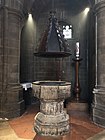St Bartholomew-the-Great
St Bartholomew-the-Great ist ein Kirchengebäude in West Smithfield in der Stadt London.[1]
Geschichte
Die Klosterkirche wurde im Jahre 1123 durch den Kanoniker Rahere als Teil eines Augustiner-Chorherrenstifts gegründet. Rahere war Hofnarr von König Heinrich I., dem Sohn Wilhelm des Eroberers. Auf einer Pilgerreise nach Rom erkrankte Rahere an Malaria. Während einer Vision sei ihm der heilige Bartholomäus erschienen und habe ihn gerettet.
Nach seiner Genesung beschloss Rahere, Augustinerchorherr zu werden. Er gründete zu Ehren des heiligen Bartholomäus ein Kloster samt angeschlossenem Hospital, das noch heute besteht und in dem Rahere und seine Mitbrüder die armen Kranken versorgten. Zum Kloster gehörte die große St. Bartholomew-the-Great-Klosterkirche. Kloster und Kirche wurden mit dem Erlös der Bartholomäus-Messe finanziert, einer der größten jährlichen Londoner Messen.[2]
Architektur
- (c) Mike Quinn, CC BY-SA 2.0
Kreuzgang der Prioratskirche
- (c) Mike Quinn, CC BY-SA 2.0
Grabmal von Prior Raherius
- (c) John Salmon, CC BY-SA 2.0
Orgel der Klosterkirche
- (c) Mike Quinn, CC BY-SA 2.0
Klosterkirche, Erkerfenster
Ausstattung
Die derzeitige Orgel in der Klosterkirche wurde 1957 von der Orgelfirma Noel Percy Mander Ltd in ein Gehäuse von 1893 eingebaut und 1982/83 von Peter Wells überholt. Seither verfügt sie über 49 Register auf drei Manualen und Pedal. Im „National Pipe Organ Register“ wird sie (Stand 2020) als unspielbar beschrieben.[3] Zur Zeit behilft man sich mit einem digitalen Instrument, bereitet aber den Einbau einer neuen Orgel von Schoenstein & Co. vor.
Literatur
- Tina Bird: St. Bartholomew-the-Great. (2008)
Siehe auch
Einzelnachweise
- ↑ www.british-history.ac.uk
- ↑ www.stbartstheless.org.uk
- ↑ St. Bartholomew the Great, West Smithfield [D03193]. In: National Pipe Organ Register. Abgerufen am 6. Dezember 2014.
Weblinks
Koordinaten: 51° 31′ 7,9″ N, 0° 5′ 58,8″ W
Auf dieser Seite verwendete Medien
Autor/Urheber: Diliff, Lizenz: CC BY-SA 3.0
The Lady Chapel of the Priory Church of St Bartholomew the Great in London, England.
(c) John Salmon, CC BY-SA 2.0
St Bartholomew the Great, West Smithfield, London EC1
(c) Mike Quinn, CC BY-SA 2.0
St. Bartholomew the Great - the cloister The cloister was lost to the church after the dissolution of the priory in 1539. Three bays were recovered in 1905 and the rest between 1923 and 1928. {Source: (leaflet) A Short Guide to the Priory Church of St. Bartholomew the Great
Autor/Urheber: Diliff, Lizenz: CC BY-SA 3.0
The view towards the altar of the Priory Church of St Bartholomew the Great in London, England.
(c) Mike Quinn, CC BY-SA 2.0
St. Bartholomew the Great - the Founder's tomb, near to London, City of London, Great Britain. The tomb of Prior Raher, north of the high altar, dates from 1405. Rahere was a courtier and favourite of King Henry I. It is thought that it was the death of the king�s wife Matilda, followed two years later by the drowning of their heir Prince William, his brother, half-brother and sister, that prompted Rahere to renounce his profession for a more worthy life and make a pilgrimage to Rome. In Rome, like many pilgrims, he fell ill. As he lay delirious he prayed for his life vowing that, if he survived, he would set up a hospital for the poor in London. His prayers were answered and he recovered. As he turned for home the vision of Saint Bartholomew appeared to him and said �I am Bartholomew who have come to help thee in thy straights. I have chosen a spot in a suburb of London at Smithfield where, in my name, thou shalt found a church.� {Source <a title="http://www.greatstbarts.com/Pages/Church/Architecture%20and%20History/history.html" rel="nofollow" href="http://www.greatstbarts.com/Pages/Church/Architecture%20and%20History/history.html">Link</a><img style="padding-left:2px;" alt="External link" title="External link - shift click to open in new window" src="http://s0.geograph.org.uk/img/external.png" width="10" height="10"/>
(c) John Salmon, CC BY-SA 2.0
St Bartholomew the Great, West Smithfield, London EC1 - Pulpitum & organ
(c) Mike Quinn, CC BY-SA 2.0
Prior Bolton's oriel window in the priory church of St Bartholomew the Great, London.
The symbol cut in the stone in the centre panel below the window is a crossbow bolt (vertical) passing through a barrel or tun - hence a pun on the Prior's name. Installed inside the church of St Bartholomew the Great in the 16th century by William Bolton, allegedly so that he could spy on the monks.
Autor/Urheber: Squib2008, Lizenz: CC BY-SA 4.0
The coat of arms of the Priory Church of St Bartholomew the Great, as displayed on the tomb of its founder, Rahere. The royal Plantagenet lions and the crowns reference Henry I of England, who issued the original charter for the foundation.
Autor/Urheber: John Greenwood (1827); Mark Annand (1998, digital version), Lizenz: CC BY 3.0
The West Smithfield area at the time of the open air livestock market, in a 1827 map by John Greenwood.





















